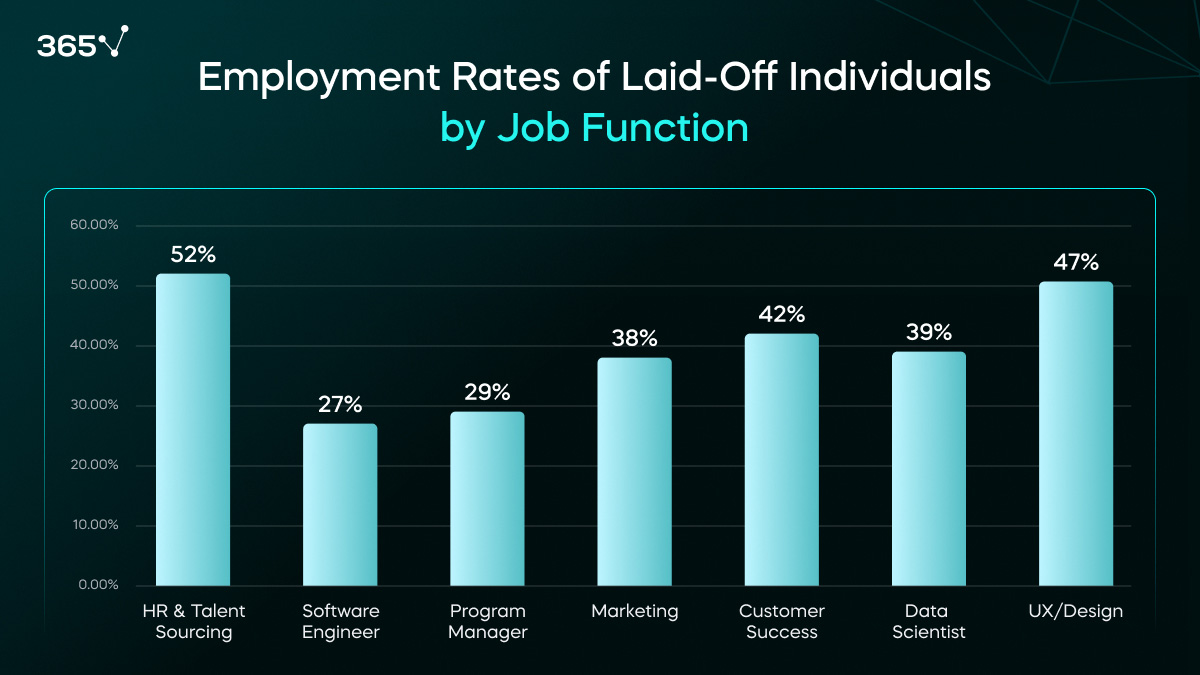Following a hiring spree in the tech sector during the pandemic, companies now resort to mass layoffs. The job cuts surpassed 150,000 in 2022 and continue in 2023, with over 13,900 new ones as of March.
Speculation about the reasons behind the job cuts varies—from preparations for the upcoming recession to plans of allocating bigger budgets to AI and automation.
But this is certain: The laid-off employees are experienced professionals with excellent qualifications. Thousands of qualified workers entered the job market over a short span, competing for the same positions during hiring freezes and continuing layoffs.
How many of them have found new positions, and where?
Our research on 1,157 workers laid off from big tech companies examines the current job market to shed light on this matter.
The Aftermath of the Big Tech Layoffs: Table of Contents
- Methodology
- How Many Found a New Job After the Tech Layoffs
- Demographics of the Laid-Off Workers with New Jobs
- A Look at Industry Transitions
- The Job Hunt by Function: Employment Rates After the Layoffs
- Navigating the Job Market After a Layoff
Methodology
We analyzed 1,157 LinkedIn profiles of people laid off from tech companies between November 2022 and January 2023. Company quotas were assigned to limit bias, and convenience sampling was employed due to data accessibility limitations.
Our findings are biased toward professionals who are active on LinkedIn and have publicly shared the news about being laid off and starting a new job. Still, results can be accepted with a reasonable degree of scientific certainty.
How Many Found a New Job After the Tech Layoffs
Our previous tech layoffs research focused on the characteristics of the laid-off individuals. It revealed that they were experienced and qualified professionals with an average work experience of 11.9 years and 2.5 years on the job before being laid off. In addition, 60% of them held bachelor's degrees.
What has happened to them since then?
Of the 1,157 laid-off individuals in our sample, 461 (39.8%) have started a new job as of March 2023. Our data reveal a faster increase in employment rates in February and March 2023 compared to the previous two months.

While the percentage of those who found a new job after being laid off increased from 5.8% in December to only 10.5% in January, there was a more notable increase to 23.8% in February and 39.8% in March. In other words, over the last two months, laid-off individuals started to find new jobs faster.
How can we interpret these findings?
Let’s start by asking, “How long does it take to find a job after a layoff?”
According to the U.S. Bureau of Labor Statistics data from February 2023, the average time required to find a job after a layoff is 8.3 weeks. This is slightly less than the pre-pandemic unemployment duration and a decrease compared to the 9.1 weeks in January and 8.9 weeks in February.
So, the rate at which laid-off workers find new jobs is increasing across industries, not just in our sample. But if we look at the tech sector in isolation, it seems that employment rates are decreasing.
According to ZipRecruiter’s 2022 research, 79% of laid-off tech workers found a new job within three months. But unlike our study, these layoff statistics represent data before the most significant job cuts starting in November 2022. Now, the job market is more saturated with qualified tech workers than in November, which makes the job search more challenging.
But this is just one of the factors behind the relatively low employment rate in our findings.
We should also consider that our study focuses on workers laid off from big tech firms known for their big salaries, good benefits, and high workload. So, some laid-off employees are taking a break to recover from burnout. Others—relying on their severance packages, savings, or another source of income—don’t feel pressured to start a new job immediately.
The increased employment rate in February and March could mean more individuals are ready to start a new job after a break.
In addition, according to our previous research, the average work experience of those laid off from November 2022 to January 2023 was 11.9 years. Being experienced professionals, some of them have started a business instead of applying for a new job.
Demographics of the Laid-Off Workers with New Jobs
Previous tech layoffs research by 365 Data Science found that women were disproportionately affected.
We examined whether this bias is reflected in the current tech layoff data, too, and discovered that, so far, men have been 22% more successful at finding a job. Only 31% of the laid-off female employees have started a new role vs 38% of the males.

In terms of age, there aren’t any drastic differences in the job search success rate. Still, laid-off employees in the 40 to 50 and 50 to 60 age ranges have more difficulty finding their next job than the older and younger.

A Look at Industry Transitions
A significant number of those with new jobs joined smaller software development firms (19%) and internet companies (13%). Still, most laid-off workers continued their careers outside of tech. Among them, 10% are in financial services, 8% in the services industry, 7% in consulting, 6% in manufacturing, only 4% in the IT sector, and 34% in other industries.

Since 59% of tech jobs are outside the tech sector, this could mean that tech skills are still in high demand across industries. Some laid-off tech workers have probably landed jobs in other sectors like financial services, consulting, manufacturing, etc.
We must also consider that the largest group of laid-off individuals in big tech firms did not hold tech-related positions. For example, specialists in HR and marketing are sought-after in every industry. So, we also analyzed the employment rates of those laid off according to their previous job function.
The Job Hunt by Function: Employment Rates After the Layoffs

HR specialists and recruiters comprised the most significant portion of laid-off employees in the tech sector (27.8%). Тhey also found new jobs more quickly—52% of which have new placements as of March 2023.
The next most successful job searches include UX/design specialists (47% with new jobs), customer success with 42%, data scientists with 39%, and marketing at 38%. All four were among the moderately affected groups—accounting for 3%, 5%, 3%, and 7% of tech layoffs, respectively.
Program managers and software engineers are finding new jobs at a slower pace than the other most affected groups. Program managers accounted for 7% of those laid off from tech firms; 29% have found new employment.
Software engineers were the second most affected group by the tech layoffs (22.1%). Yet, their job is the least successful, with only 27% starting new jobs as of March 2023.
This doesn’t mean that software engineering skills are no longer in demand, nor that the tech sector’s golden days are over. But we can feel the winds of change reshaping the job market.
Navigating the Job Market After a Layoff
Indeed’s annual research reveals that tech jobs are still among the most in-demand and well-paid positions in 2023. But a comparison with previous years’ data shows that although it’s still the hottest job market, the demand for tech workers is starting to decline.
The tech sector is widely considered a source of economic growth and innovation, contributing to the public’s concern regarding the economy’s future. Still, big tech companies comprise a small part of the job market, which remains stable. With low unemployment rates and 1.7 open positions for every person looking for a job, is there cause for concern?
Skeptics may interpret this as the end of the tech sector’s golden years, but most experts argue it’s simply a correction of the record-high hiring levels during the pandemic.
Either way, the fact is that technology has become an inseparable part of every sector. The rapid development of AI is changing the job market for tech workers. Some skills or jobs may become obsolete due to technological advancements and automation—but only to make room for new ones.
Tech skills are still invaluable, and specialists will remain highly sought-after. But one must recognize the changing landscape, adapt to it, and upskill to stay relevant. After all, technologies like ChatGPT are only possible thanks to the highly skilled workforce behind them.
Regardless of your field of work, you can learn to leverage AI tools to increase your productivity. Take our Intro to ChatGPT and Generative AI course to get started.
Sign up for 365 Data Science and try our program for free.









